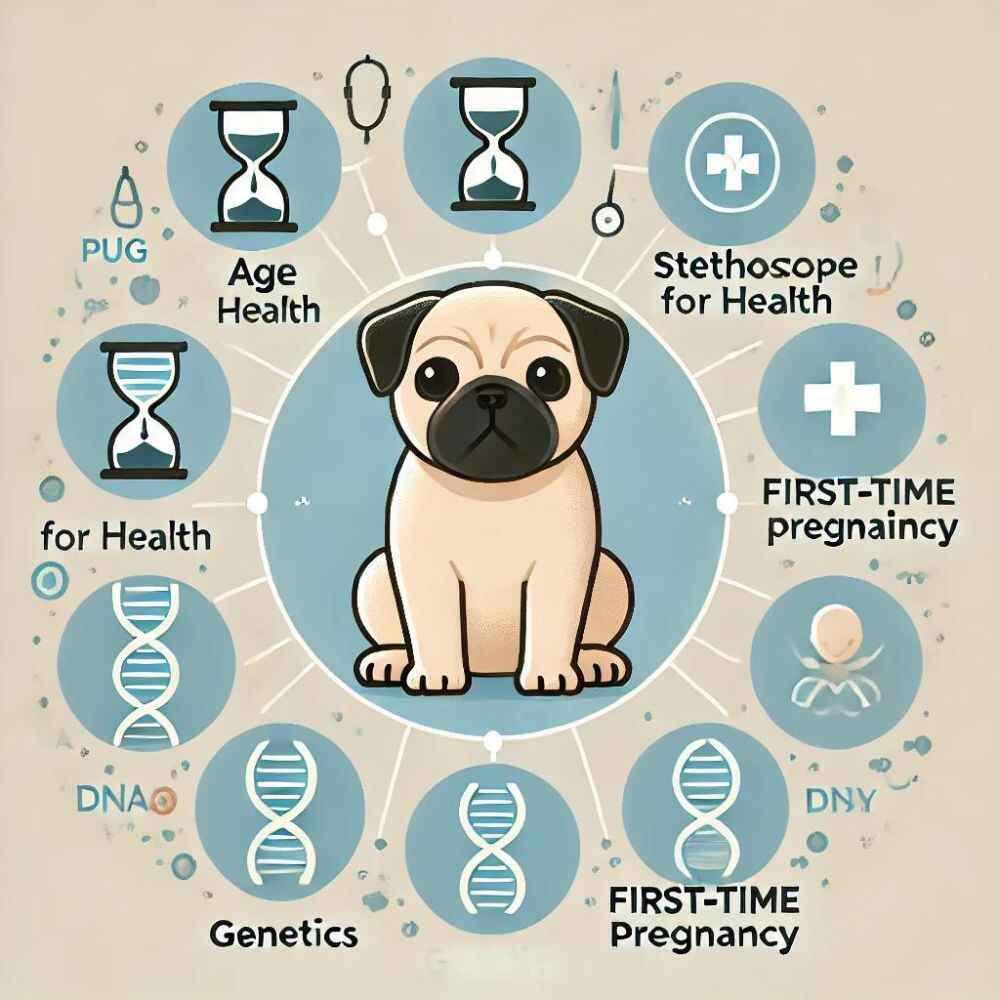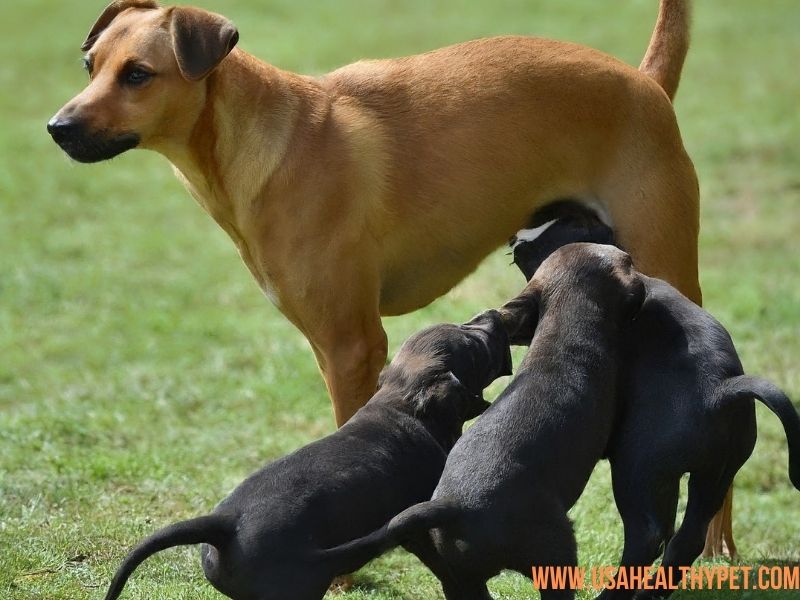If you’re thinking about breeding your pug or expecting a litter soon, you’re probably wondering, “How many puppies can a pug have?” the answer isn’t always straightforward.
Just like humans, no two pregnancies are the same! Knowing what to expect can help you prepare for those adorable little bundles of joy.
So, let’s dive into all the details and find out what affects the number of puppies your pug might have.
Average Number of Puppies in a Pug Litter
On average, pugs typically have around 4 to 6 puppies in a litter.
However, some pugs may have fewer, like 1 or 2 puppies, while others could surprise you with as many as 9! This range depends on several factors, including the age, health, and genetics of the pug.
According to Dr. Lisa, “Most pugs have around 4 to 6 puppies, but we do see variations. For first-time mothers, smaller litters—sometimes just one or two pups—are quite normal. A pug’s overall health plays a big role. If your pug is well-cared for, fed a balanced diet, and kept at a healthy weight, she’s more likely to have a smooth pregnancy.”
Factors That Affect the Size of a Pug Litter

While 4 to 6 puppies are the norm, several things can influence litter size. Let’s break them down.
1. Age of the Mother
Did you know that a pug’s age plays a significant role in how many puppies she can have?
Younger pugs, especially in their first heat, may have smaller litters. The most fertile period for a pug is generally between the ages of 2 and 5 years. After 5, her litter size might decrease as she ages.
2. Health of the Pug
Just like with humans, a pug’s overall health will impact her pregnancy. A pug in good health, receiving proper nutrition and care, is more likely to have a normal-sized litter.
However, if she suffers from any health problems or obesity, it can affect the number of puppies.
3. Genetics and Lineage
The litter size can also be hereditary. If your pug comes from a line of dogs that typically have larger litters, she’s more likely to have a bigger litter herself. Similarly, smaller litters could run in the family.
Emma, a seasoned breeder, explains that “the size of a pug litter can also depend on the breeding line.” She adds, “I’ve had pugs from certain lines consistently have 5 or 6 puppies, while others might have only 3. It’s really a mix of genetics and luck sometimes!”
4. First-Time Pregnancies vs. Later Pregnancies
Pugs having their first litter often tend to have fewer puppies than in later pregnancies. It’s common for the first litter to be smaller—think of it as her body adjusting to the pregnancy process. In subsequent pregnancies, she might have more pups.

How to Know if Your Pug is Pregnant
Wondering if your pug is pregnant? It’s not always obvious in the early stages, but there are a few signs to watch out for:
- Decreased activity: Your usually energetic pug may seem a little lazier.
- Changes in appetite: She might eat more or less than usual.
- Nipple enlargement: Her nipples will become more pronounced and slightly darker.
- Behavioral changes: Pregnant pugs can become more affectionate or, sometimes, more withdrawn.
If you’re still unsure, a trip to the vet is the best way to confirm a pregnancy.
Caring for a Pregnant Pug
Pregnancy is a special time for your pug, and she needs a little extra TLC during these weeks. Here are some tips to ensure she stays healthy and happy:
- Feed her a nutritious diet: Choose a high-quality dog food that’s rich in protein and nutrients to support her growing puppies.
- Regular, gentle exercise: While it’s important to keep her active, avoid strenuous exercise or overexertion.
- Vet visits: Regular checkups will ensure everything is progressing smoothly and give you peace of mind.
What to Expect During Labor and Delivery
When the big day comes, it can be both exciting and nerve-wracking. Pugs usually go into labor between 58 and 65 days after conception. Signs that labor is approaching include:
- Restlessness: She may pace around or appear anxious.
- Nesting behavior: Your pug might start looking for a quiet, cozy spot to give birth.
- Panting and shaking: These are common signs of discomfort before labor.
Once labor starts, it typically takes a few hours for all the puppies to be delivered. If you’re unsure how to handle the delivery, having a vet on standby can be a huge relief.
Can Pugs Have Large Litters?
While pugs aren’t known for having massive litters like some larger breeds, there are instances where a pug may have up to 9 puppies.
It’s not common, but it’s possible! If your pug has a larger litter, be prepared to give each puppy a lot of attention—feeding, care, and vet visits will increase with more puppies in the mix.

What Happens If the Litter Is Small?
On the other hand, some pugs only have 1 or 2 puppies in a litter. This is more common with smaller breeds or in first-time pregnancies.
According to a study published in the journal Theriogenology, smaller dog breeds, like pugs, tend to have smaller litters compared to larger breeds. This is due to their physical size and anatomical differences. However, even in small breeds, factors such as the mother’s age, size, and overall health significantly influence how many puppies she can have.
A small litter isn’t necessarily a bad thing! It can make it easier to care for each puppy individually, as they won’t have to compete for their mom’s attention.
How to Care for Newborn Pug Puppies
Newborn puppies are tiny and fragile, requiring a lot of care and supervision. Here are a few basic tips:
- Keep them warm: Puppies can’t regulate their body temperature for the first few weeks, so ensure they have a warm environment.
- Monitor feeding: Make sure all puppies are nursing properly and gaining weight.
- Cleanliness: Keep their area clean to prevent infections.
When Should You Take the Puppies to the Vet?
It’s important to get your newborn puppies checked by a vet within the first 48 hours of birth. This helps ensure that both mom and baby are healthy.
The vet will check for any birth defects, make sure they’re feeding properly, and advise on how to care for the litter as they grow.
Conclusion: Understanding the Life Cycle of a Pug Mom and Her Puppies
Bringing a new litter of pug puppies into the world is an exciting adventure. Whether your pug has a small or large litter, the joy of seeing those little faces and watching them grow is unmatched.
By knowing what to expect—how many puppies she might have, how to care for her during pregnancy, and how to ensure the puppies are healthy—you’re setting yourself and your pug up for success.
If you’re ever unsure about any part of the process, don’t hesitate to reach out to a vet for professional advice. Enjoy the journey of puppy parenthood—it’s an experience full of love, cuteness, and some puppy chaos!
FAQs About Pug Litters
1. Can a pug have more than 6 puppies?
Yes, while the average pug litter is between 4 to 6 puppies, it’s possible for a pug to have as many as 9 puppies, though it’s rare.
2. How many litters can a pug safely have in her lifetime?
Most breeders recommend limiting a pug to 3 to 4 litters over her lifetime to ensure her health and well-being.
3. How long does a pug stay pregnant?
A pug’s pregnancy typically lasts between 58 to 65 days.
4. Is it dangerous for pugs to give birth?
Pugs, like other small breeds, can sometimes experience difficulties during birth, so it’s important to monitor the labor and consult with a vet if there are complications.
5. Can pugs have puppies naturally, or do they need a C-section?
Most pugs can give birth naturally, but due to their small size and the shape of their heads, some may require a C-section, especially if there are complications during delivery.
